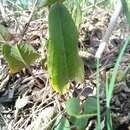Comments
provided by eFloras
Rumex confertus was placed in subsect. Conferti Rechinger f. This species is common and ecologically successful in central and eastern Europe; it may be expected elsewhere in temperate regions of North America.
- license
- cc-by-nc-sa-3.0
- copyright
- Missouri Botanical Garden, 4344 Shaw Boulevard, St. Louis, MO, 63110 USA
Description
provided by eFloras
Herbs perennial. Stems erect, 40-50 cm tall, branched above, grooved, papillose-pubescent. Basal leaves with petiole longer than leaf blade; leaf blade deeply cordate-triangular, 8-10 × 15-20 cm, slightly longer than wide, abaxially papillate, adaxially glabrous, margin undulate, basal lobes and apex rounded. Inflorescence paniculate, 5-6 × 18-20 cm; rachis flexuous; branches arcuate at base. Flowers bisexual. Pedicel slender, articulate below middle. Inner tepals enlarged in fruit; valves broadly cordate, acutely reniform, 5-6 × 7-8 mm, one valve with a small tubercle, conspicuously net veined, margin with indistinct teeth near base. Fl. May-Jun.
- license
- cc-by-nc-sa-3.0
- copyright
- Missouri Botanical Garden, 4344 Shaw Boulevard, St. Louis, MO, 63110 USA
Description
provided by eFloras
Plants perennial, glabrous or weakly papillose-pubescent espe-cially when young, with fusiform, vertical to oblique rootstock or short rhizomes. Stems erect, branched above middle, 50-100(-130) cm. Leaves: ocrea mostly deciduous or rarely partially persistent at maturity; blade ovate-triangular, broadly ovate, or ovate-elliptic, 20-30 × 15-25 cm, base deeply and broadly cordate, margins entire to obscurely repand, usually slightly crisped or undulate, apex obtuse to subacute. Inflorescences terminal, occupying distal 2 of stem (branches often slightly arcuate at base), rather dense, widely paniculate. Pedicels articulated in proximal 3, filiform, 4-10 mm, articulation distinctly swollen. Flowers 15-30 in whorls; inner tepals orbiculate-reniform or broadly scutate, 6-9 × 6-11 mm, as long as wide or nearly so, base cordate to subcordate, margins entire or subentire, occasionally irregularly erose near base, apex abruptly acute to acute; tubercles usually 1, small, 1-2 mm, normally less than 2 times as wide as inner tepals, rarely absent or indistinct. Achenes reddish brown, 3-3.5 × 1.7-2.5 mm. 2n =40.
- license
- cc-by-nc-sa-3.0
- copyright
- Missouri Botanical Garden, 4344 Shaw Boulevard, St. Louis, MO, 63110 USA
Distribution
provided by eFloras
introduced; Alta., Man.; N.Dak.; e, ec Europe; w Asia (the Caucasus, Siberia); introduced elsewhere.
- license
- cc-by-nc-sa-3.0
- copyright
- Missouri Botanical Garden, 4344 Shaw Boulevard, St. Louis, MO, 63110 USA
Flowering/Fruiting
provided by eFloras
Flowering late spring-summer.
- license
- cc-by-nc-sa-3.0
- copyright
- Missouri Botanical Garden, 4344 Shaw Boulevard, St. Louis, MO, 63110 USA
Habitat
provided by eFloras
Roadsides, waste places, meadows, river valleys; 300-700m.
- license
- cc-by-nc-sa-3.0
- copyright
- Missouri Botanical Garden, 4344 Shaw Boulevard, St. Louis, MO, 63110 USA
Habitat & Distribution
provided by eFloras
Meadows in river valleys. N Xinjiang [Kazakhstan, Russia; Europe, North America].
- license
- cc-by-nc-sa-3.0
- copyright
- Missouri Botanical Garden, 4344 Shaw Boulevard, St. Louis, MO, 63110 USA
Synonym
provided by eFloras
Rumex alpinus Linnaeus var. subcalligerus Boissier
- license
- cc-by-nc-sa-3.0
- copyright
- Missouri Botanical Garden, 4344 Shaw Boulevard, St. Louis, MO, 63110 USA
Rumex confertus
provided by wikipedia EN
Rumex confertus (Russian dock) is a flowering plant species in the family Polygonaceae. It grows quickly, reproduces from rhizomes and seed, and produces large quantities of viable seed. Its seed is adapted for wind and water dispersal and exhibits a high rate of germination.
Distribution
Rumex confertus flowering usually occurs late spring-summer. Along roadsides, waste places, meadows, river valleys. This species is common in central and Eastern Europe, can be expected elsewhere in mild climate regions of North America.[1]
Uses
The Rumex L. (dock) species have been used in medical treatment for many centuries.[2]
References

- license
- cc-by-sa-3.0
- copyright
- Wikipedia authors and editors
Rumex confertus: Brief Summary
provided by wikipedia EN
Rumex confertus (Russian dock) is a flowering plant species in the family Polygonaceae. It grows quickly, reproduces from rhizomes and seed, and produces large quantities of viable seed. Its seed is adapted for wind and water dispersal and exhibits a high rate of germination.
- license
- cc-by-sa-3.0
- copyright
- Wikipedia authors and editors

